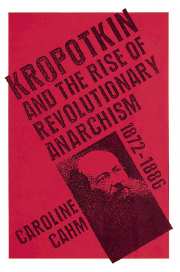Book contents
- Frontmatter
- Contents
- Preface
- Acknowledgements
- Introduction
- Part I Kropotkin and the development of the theory of anarchist communism
- Part II Kropotkin and the development of anarchist ideas of revolutionary action by individuals and small groups (1872–1886)
- Part III Kropotkin and the development of anarchist views of collective revolutionary action (1872–1886)
- 9 Trade unionism and the emergent anarchist movement of the seventies
- 10 Kropotkin and collective action in the labour movement
- Conclusion
- Notes
- Bibliography
- Index
10 - Kropotkin and collective action in the labour movement
Published online by Cambridge University Press: 14 September 2009
- Frontmatter
- Contents
- Preface
- Acknowledgements
- Introduction
- Part I Kropotkin and the development of the theory of anarchist communism
- Part II Kropotkin and the development of anarchist ideas of revolutionary action by individuals and small groups (1872–1886)
- Part III Kropotkin and the development of anarchist views of collective revolutionary action (1872–1886)
- 9 Trade unionism and the emergent anarchist movement of the seventies
- 10 Kropotkin and collective action in the labour movement
- Conclusion
- Notes
- Bibliography
- Index
Summary
Early hostility to trade unions: his denunciation of British trade unionism
It would seem that Kropotkin had been enthusiastic in his initial reaction to the syndicalist ideas of the Anti-authoritarian International. He first visited the bakuninists of the Jura and Verviers in 1872, at a time when both the Belgian and Swiss federations had been associated with successful strike action. He was profoundly impressed by the trade union solidarity achieved and the ‘revolutionary character of the agitation of the workers’ in the Jura. He declared that ‘the great mass and the best elements of the Belgian coalminers and weavers had been brought into the International’, and described the clothiers of Verviers as ‘one of the most sympathetic populations that I have ever met in Western Europe’.
But his enthusiasm for the workers of Verviers and the Jura did not lead him to adopt the syndicalist views of the bakuninists. Indeed, he began with a fairly negative approach. This comes out quite clearly in his discussions of trade union organisation and activity in the manifesto he prepared for the Chaikovsky Circle in 1873.
In this document, he urged the identification of the revolutionary with any local disturbances with a limited aim (e.g. a demonstration against a foreman or manager at a factory, a demonstration against some restraining measure, a disturbance in a village with the aim of removing the foremen, the clerks, the middlemen, and so on) because they provided an opportunity for developing a more general opposition to oppression among the masses.
- Type
- Chapter
- Information
- KropotkinAnd the Rise of Revolutionary Anarchism, 1872-1886, pp. 231 - 269Publisher: Cambridge University PressPrint publication year: 1989



